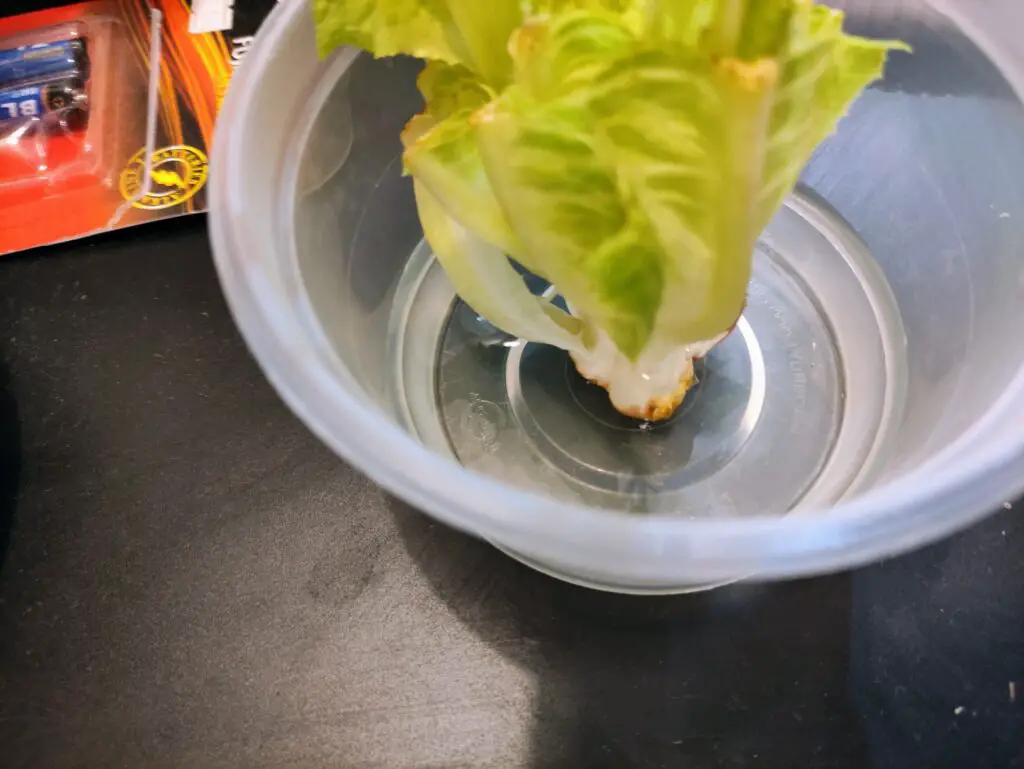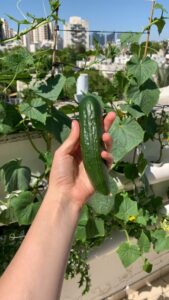When I think of “regular lettuce”, what comes to mind is romaine lettuce. Romaine lettuce is a versatile and nutritious vegetable that can easily be grown hydroponically, using simple techniques and tools. Whether you’re looking to grow your own fresh produce at home, or just want to try out a new growing method, hydroponic romaine lettuce cultivation is an excellent option for any lettuce loving gardener:
What is romaine lettuce?
Romaine lettuce, also known as cos or stem lettuce, is a nutrient-rich vegetable that can be grown in a variety of ways. From traditional soil-based gardening to more modern hydroponic systems, romaine lettuce can be cultivated with ease and simplicity.
Romaine lettuce has a tender, crisp texture and mildly sweet flavor that makes it a popular choice for salads and other dishes. The leaves are long and narrow, with smooth edges and slightly serrated lobes. Romaine lettuce leaves can be dark green or almost purplish in color. Its inside leaves are yellowish.
The root system of romaine lettuce is shallow and fibrous, which makes it a good candidate for hydroponic cultivation. Hydroponic systems use water to deliver nutrients directly to the roots of plants, without the need for soil or other growing media. This allows you to grow your romaine lettuce using less space and with minimal effort while maintaining high levels of quality, nutrition, and flavor.
Romaine lettuce growth by numbers
- 12-14 (30-35) inches between seeds, or about 8 inches (20 cm) for small plants
- 7-10 weeks to grow before harvest
- 73ºF (23ºC) during the day and 45ºF (7ºC) at night is the optimal temperature
- 5.5-6.0 pH level
- 12-16 hours of light.
Key steps for hydroponic romaine lettuce
If you’re interested in growing your own romaine lettuce hydroponically, there are a few key steps to keep in mind.
- First, make sure that you have a dedicated space for your plants, whether this is an indoor or outdoor garden bed.
- Next, choose a nutrient-rich medium to support the roots of your plants, such as perlite, coconut husk, or vermiculite.
- Once you have your growing medium chosen and prepared, it’s time to start planting your seeds. To do this, simply place the seeds into small holes about 1 inch deep in the growing medium. Make sure that each hole is spaced at least 6 inches apart, and that the top of each seed is just above the surface of the medium.
- Once you have planted all of your seeds, water them gently but thoroughly to moisten the growing medium.
- Once your romaine lettuce begins to sprout, it’s important to adjust how much water you are giving your plants. Overwatering can cause your plants to become moldy, while not watering them enough will lead to a stunted growth rate. To find the right balance, be sure to regularly monitor how wet your growing medium is and adjust accordingly.
As your romaine lettuce grows and develops, you may need to transfer it from one plant pot to another in order to give it the space that it needs. You can also add additional nutrients to your growing medium, such as liquid fish or seaweed fertilizer, in order to encourage healthy and vigorous growth.
Pro-tips on how to grow romaine lettuce hydroponically
Can I grow romaine lettuce from scraps?
Oh, yeah. You can grow your own romaine lettuce from scraps. Just place the scraps in water and wait for some root. Once there is some root, move it to a hydroponic system.

Is romaine lettuce good for hydroponics?
Yes, romaine lettuce is an ideal crop to grow hydroponically. With proper care and attention, you can grow healthy, vibrant romaine lettuce plants using simple techniques and tools.
Some key factors to keep in mind when growing romaine lettuce in a hydroponic system include choosing the right seeds and planting spacing, providing adequate light and temperature, and maintaining the nutrient-rich water solution. Whether you’re a novice gardener or an experienced hydroponic farmer, growing romaine lettuce in a hydroponic system is a great way to enjoy fresh, home-grown produce all year round!
What is the best hydroponic system for romaine lettuce?
There are many different hydroponic systems that you can use to grow your romaine lettuce, depending on your needs and preferences. Some popular options include deep water culture (DWC), nutrient film technique (NFT), ebb and flow, and aeroponics. This is not unique to romanie lettuce, but to all lettuce types.
Ultimately, the best system for growing romaine lettuce will depend on factors such as the size of your plants, how much space and light you have available, and how much effort you’re willing to put into maintaining and monitoring your system. In other words: there is no one best system, but it’s up to your personal preferences.
Ultimately, the right choice will depend on your personal preferences and growing conditions, so it’s best to experiment with different systems until you find the one that works best for you.
Temperature
A University of California’s recent report claims that the best temperatures for lettuce growth are 73ºF (23ºC) during daylight hours and 45ºF (7ºC) at night. You can maintain those conditions by planting them either in spring or fall, using a grow tent to monitor the temperature inside.
What nutrients are needed to grow romaine lettuce?
When growing romaine lettuce in a hydroponic system, it’s important to provide the plants with regular doses of key nutrients like nitrogen, phosphorus, and potassium. To ensure optimal growth and development, you may also need to add micronutrients like calcium, magnesium, zinc, and iron. There are several different ways to add these nutrients to your hydroponic system, including liquid fertilizers, slow- or controlled-release fertilizers, and foliar feeds.
To grow healthy romaine lettuce plants in a hydroponic system, be sure to regularly monitor and adjust the nutrient levels as needed. This will help ensure that your plants are getting all of the nutrients they need to thrive and that they’re not being exposed to high levels of any one nutrient, which can cause plant damage or even death. Additionally, regularly checking the pH level of your hydroponic solution is also important for optimal romaine lettuce growth. The ideal pH range for romaine lettuce is 5.5-6.0, so it’s important to regularly test and adjust your water as needed to keep it within this range.
How long does romaine lettuce take to grow hydroponically?
Depending on a variety of factors, such as the type of hydroponic system you’re using and how carefully you monitor and care for your plants, it typically takes between 7-10 weeks to grow romaine lettuce hydroponically. To ensure healthy growth and development, be sure to provide your plants with adequate light, nutrients, and water, and to carefully monitor the pH level of your hydroponic solution.
Additionally, be sure to prune any dead or damaged leaves and harvest your romaine lettuce regularly so that it has time to replenish its nutrients for continued growth and development.
Conclusion: Can romaine lettuce be grown hydroponically?
Yes, romaine lettuce can be grown hydroponically with the right care and attention. To grow healthy, robust romaine lettuce plants in a hydroponic system, it’s important to provide your plants with the right nutrients, light, and water conditions. Additionally, regular monitoring and maintenance of your hydroponic system will help ensure optimal growth and development of your plants. With the right care and attention, you can grow beautiful, healthy romaine lettuce hydroponically in just 7-10 weeks. So if you’re looking for an efficient and environmentally-friendly way to grow this popular leafy green vegetable at home, consider giving hydroponics a try!
If you are into growing hydroponic lettuce, check out our hydroponic iceberg lettuce guide.
FAQ
Yes, romaine lettuce is a great vegetable to grow hydroponically, as it can thrive in a variety of conditions and is relatively easy to care for.
It typically takes between 7-10 weeks to grow romaine lettuce hydroponically, depending on factors such as the type of system you’re using and how carefully you monitor your plants’ growth.
The best time to begin growing hydroponic romaine lettuce is during the early spring or late summer when conditions are optimal for plant growth. Alternatively, you can use a grow tent to control the temperature.
Some key nutrients needed for romaine lettuce growth include nitrogen, phosphorus, and potassium, as well as micronutrients like calcium, magnesium, zinc, and iron. These nutrients can be added to your hydroponic system through a variety of different nutrients, such as liquid fertilizers, slow- or controlled-release fertilizers, and foliar feeds.




